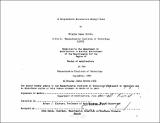| dc.contributor.advisor | Robert J. Slattery. | en_US |
| dc.contributor.author | Brooks, Douglas James | en_US |
| dc.contributor.other | Massachusetts Institute of Technology. Dept. of Architecture. | en_US |
| dc.coverage.spatial | n-us--- | en_US |
| dc.date.accessioned | 2012-07-02T15:18:51Z | |
| dc.date.available | 2012-07-02T15:18:51Z | |
| dc.date.copyright | 1982 | en_US |
| dc.date.issued | 1982 | en_US |
| dc.identifier.uri | http://hdl.handle.net/1721.1/71337 | |
| dc.description | Thesis (M. Arch.)--Massachusetts Institute of Technology, Dept. of Architecture, 1982. | en_US |
| dc.description | MICROFICHE COPY AVAILABLE IN ARCHIVES AND ROTCH. | en_US |
| dc.description | Includes bibliographical references (p. 196-198). | en_US |
| dc.description.abstract | A design that proposes the redefinition of the role of a power plant facility within a community by creating a humane environment for recreation, education, community gathering, living, and energy production; rather than the traditional remote and often inhumane environments of the present. This thesis explores the design of a small scale alternative energy plant as the center of a new framework for revitalizing small industries, developing industrial cogeneration of energy, and redeveloping mixed use commercial, office, and residential areas within the context of a deteriorated urban neighborhood. Located in a historic area of Rockford, Illinois, the design incorporates some fifty new passive solar residences and a 34,000 square foot clean energy plant within an eleven and one- half acre inner-city site. Fueled by the sun, the wind, the Rock River, and the community's municipal refuse and sewage, this neighborhood alternative energy plant (NAEP) represents not only a renewable energy resource, but both a recreational and educational resource as well. The challenge of this project is to provide an integrated alternative method for both producing power and participating in its production. Included in the design of this NAEP are: an overview of alternative energy use in architecture and community planning; a history of small scale power generation within the context of the neighborhood; a master plan for the site; design of the facility; and energy and economic analysis, designed to demonstrate the viability of the project within a contemporary marketplace. | en_US |
| dc.description.statementofresponsibility | by Douglas James Brooks. | en_US |
| dc.format.extent | 200 p. | en_US |
| dc.language.iso | eng | en_US |
| dc.publisher | Massachusetts Institute of Technology | en_US |
| dc.rights | M.I.T. theses are protected by
copyright. They may be viewed from this source for any purpose, but
reproduction or distribution in any format is prohibited without written
permission. See provided URL for inquiries about permission. | en_US |
| dc.rights.uri | http://dspace.mit.edu/handle/1721.1/7582 | en_US |
| dc.subject | Architecture. | en_US |
| dc.subject.lcsh | Public utilities United States | en_US |
| dc.subject.lcsh | Power-plants Design and construction | en_US |
| dc.subject.lcsh | Architecture and energy conservation | en_US |
| dc.title | A neighborhood alternative energy plant | en_US |
| dc.type | Thesis | en_US |
| dc.description.degree | M.Arch. | en_US |
| dc.contributor.department | Massachusetts Institute of Technology. Department of Architecture | |
| dc.identifier.oclc | 09343378 | en_US |
